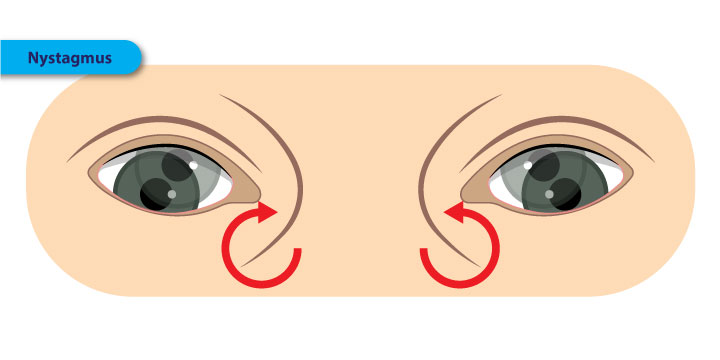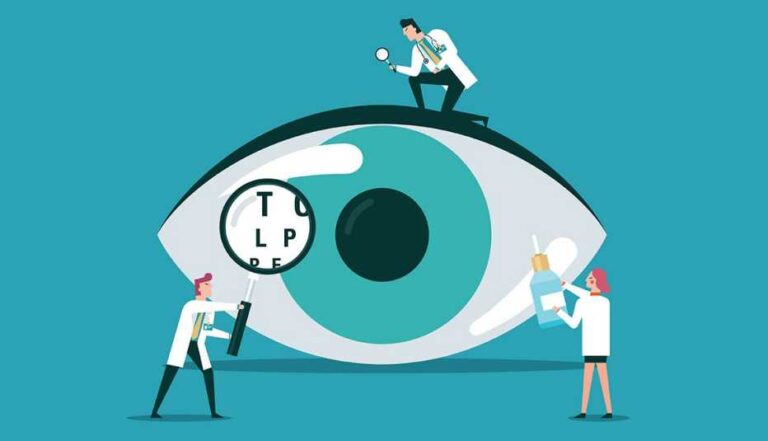Eye movments- noticing change in my child’s eyes
Have I ever noticed change in my child’s eye movements. Is my observation about my child’s eye movements is correct?. Well, YES. The noticing of peculiar gaze, head posture and not so normal eye movements in a toddler can be alarming for something interfering the normal brain functioning.

There are following abnormal patterns that parents can observe after their child is born normal :
Deviation in eyes
The child’s one eye or both eyes have started deviating from normal central gaze to any of the gaze: inward, outward, upward, downward.
Adapting head posture
The child has started developing head posture while looking into objects i.e. he sees things by tilting head in a certain way and find comfort in it.
Eyeball uncontrolled movements
The child’s eyeball starts moving for a certain period of time and this has never happened before. This literal term of eye ball movements is called “Nystagmus“.

In any of these cases, it is necessary to consult the ophthalmologists becasue any of the acquired condition can be the call for:
Eye movements and brain tumors
Brain tumors, whether non-cancerous or cancerous, can press on parts of the brain that control eye movements. When tumors are located in areas like the cerebellum or brainstem—which help regulate coordination and balance—they can lead to nystagmus. Along with these unusual eye movements, children might experience trouble focusing their eyes, feel dizzy, or notice changes in their vision. If you spot these signs, it’s essential to consult a doctor right away.
Eye movements and cranial nerve palsies
Damage or dysfunction of cranial nerves (III, IV, or VI) responsible for eye movement can result in eye misalignment. For example:
- Third Nerve Palsy (Oculomotor Nerve): Causes droopy eyelid (ptosis) and outward deviation of the eye.
- Fourth Nerve Palsy (Trochlear Nerve): Leads to upward deviation of the eye.
- Sixth Nerve Palsy (Abducens Nerve): Causes inward deviation of the eye.

Traumatic brain injuries
Traumatic brain injuries (TBI) can affect eye movement control centers in the brainstem or cerebellum, leading to strabismus.
Cerebral palsy
Children with cerebral palsy often exhibit strabismus due to impaired coordination of eye muscles.
Orbital trauma
Injury to the eye socket or surrounding tissues can damage eye muscles, resulting in misalignment.
Unilateral or bilateral vision loss
If one eye loses vision, it may deviate over time because the brain stops using it for focusing.
Cataracts and corneal opacities
These conditions reduce visual input, leading to poor coordination between the eyes.
Cerebellar ataxia
Cerebellar ataxia occurs when the cerebellum—the part of the brain that controls coordination—becomes damaged or dysfunctional. This condition can result from infections, genetic disorders, or inflammation. Children with cerebellar ataxia often exhibit nystagmus alongside other symptoms such as unsteady gait, difficulty with fine motor skills, and slurred speech. Treating the underlying cause is key to managing nystagmus and improving overall coordination.
Inflammatory conditions
Certain infections and inflammatory conditions affecting the brain can lead to nystagmus. These include:
- Encephalitis: Inflammation of the brain caused by viral or bacterial infections can disrupt eye movement control.
- Meningitis: Inflammation of the protective membranes around the brain and spinal cord may impair neurological functions, including eye coordination.
- Autoimmune Disorders: Conditions like acute disseminated encephalomyelitis (ADEM) can cause brain inflammation and trigger nystagmus.
Early intervention leading to spot on diagnosis
Acquired nystagmus and deviation in eye in children is often a symptom of an underlying neurological issue rather than a standalone condition. Identifying the root cause through thorough medical evaluations, including imaging and neurological exams, is crucial. Early diagnosis allows for targeted treatment, which may include medication, surgery, or therapy, depending on the condition.
Founder of EyesMatterMost- an optometry student who loves talking about eyes. I tend to cover topics related to optometry, ophthalmology, eye health, eyecare, eye cosmetics and everything in between. This website is a medium to educate my readers everything related to eyes.

